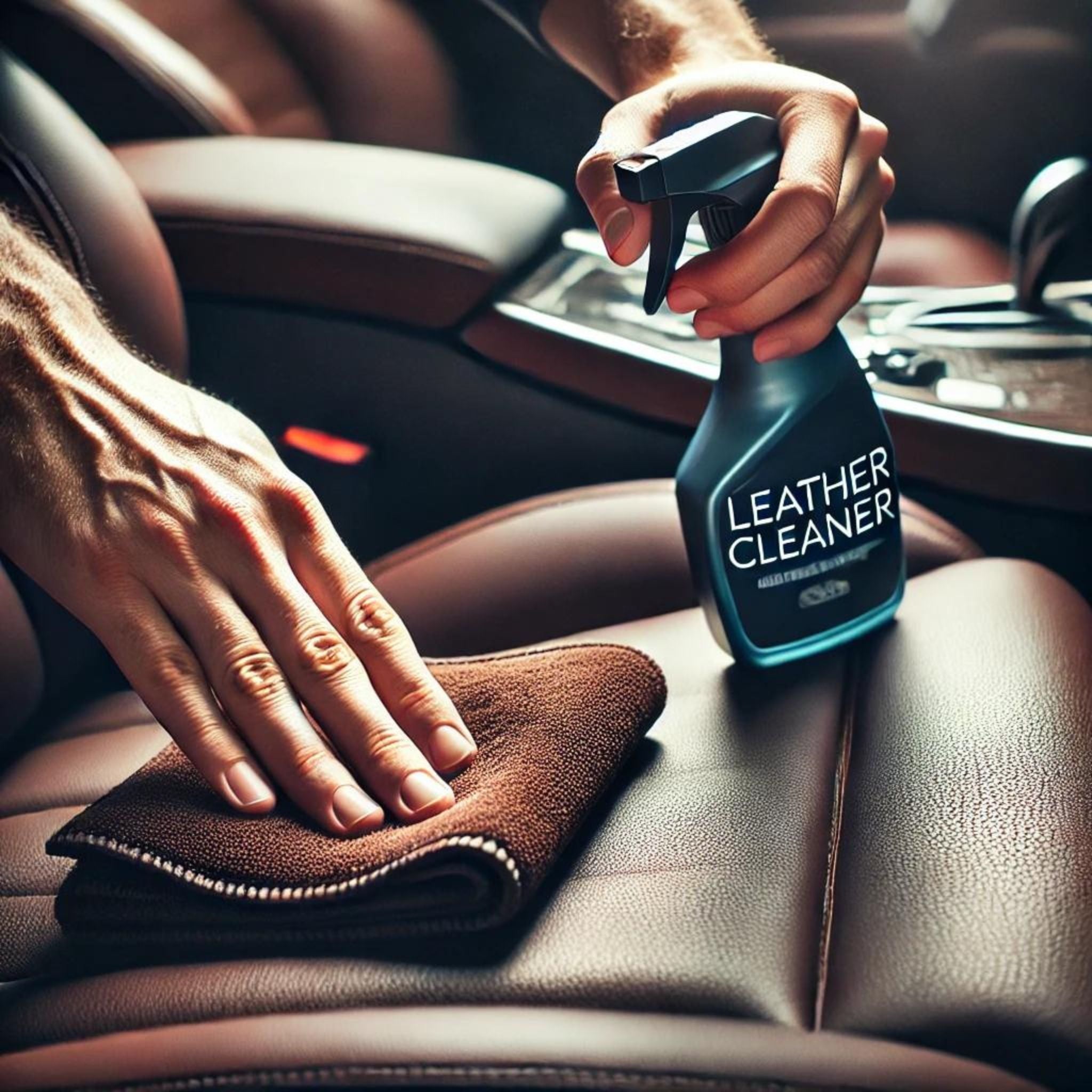Leather car seats add a luxurious touch to your vehicle, but maintaining that elegance can be tricky. Many car owners hesitate when it comes to cleaning their leather seats, fearing they might damage the material. Over time, dirt, spills, and oils from your skin can make leather seats look dull and worn. Worse yet, improper cleaning methods can cause cracking, discoloration, or fading, leading to expensive repairs or replacements.
However, cleaning your car's leather seats without damaging them is entirely possible with the right products and techniques. The key is to use gentle, leather-safe methods that remove dirt and stains while preserving the leather's natural oils.
Types of Leather Used in Cars

Before cleaning your leather seats, it’s important to understand the type of leather used in your vehicle. Different leathers require slightly different care.
Aniline Leather
Aniline leather is a high-quality and untreated leather that retains its natural look and feel, making it exceptionally soft and comfortable. Because it lacks any protective coating or finish, it is highly porous, which makes it more susceptible to absorbing stains and showing scratches.
Its natural texture can be easily damaged by spills, sunlight, and wear, requiring careful maintenance and regular conditioning. Despite its delicacy, many people value aniline leather for its luxurious and authentic appearance.
Semi-Aniline Leather
Semi-aniline leather strikes a balance between natural feel and durability. It has a light protective coating, which offers better resistance to stains and wear compared to aniline leather, while still retaining much of the softness and natural appearance.
The coating helps guard against minor spills and scratches, but the leather remains breathable and comfortable. It offers a luxurious look with less vulnerability than fully untreated leather.
Pigmented (Protected) Leather
Most car leather is classified as pigmented or protected leather, which features a synthetic protective coating. This coating enhances its resistance to stains, scratches, and general wear, making it a practical choice for daily use. The finish also makes the leather easier to clean and maintain, as it shields the material from absorbing spills and grime. While not as soft as untreated leather, it is more durable and long-lasting.
Tools and Products to Clean Car Interior Leather

What to clean leather car interior with? To clean your car's leather without causing damage, it’s important to use the right tools and products. Here’s what you’ll need:
Microfiber Cloths: Soft cloths that won't scratch or damage the leather.
Leather Cleaner: A gentle cleaner designed specifically for automotive leather.
Leather Conditioner: A product that replenishes moisture, keeping the leather soft and preventing cracks.
Soft-Bristle Brush: Helpful for gently scrubbing stains without damaging the leather.
Step-by-Step Guide to Cleaning Car Leather Without Damage

Vacuum the Seats
Before applying any cleaner, it's crucial to remove loose dirt and debris from the leather seats. Dirt particles can scratch the leather during the cleaning process.
- Use a vacuum with a soft brush attachment to remove all dust and debris.
- Be sure to get into the crevices and seams where dirt tends to accumulate.
Test Cleaning Products in an Inconspicuous Area
Always test any cleaning product on a small, hidden area of the seat before applying it to the entire surface. This ensures that the product won’t cause discoloration or damage to your leather.
- Apply a small amount of cleaner to a hidden area.
- Let it sit for a few minutes and then wipe it off to check for any adverse reactions.
Use a Leather Cleaner for Gentle Cleaning
Once you’re sure the cleaner is safe, you can begin cleaning the seats.
- Apply the leather cleaner to a microfiber cloth, not directly onto the leather.
- Gently wipe down the seats, working in small sections at a time. Avoid scrubbing too hard, as this can damage the surface.
- For tougher stains, use a soft-bristle brush to gently work the cleaner into the leather, but be sure not to over-saturate the area.
Wipe with a Damp Cloth
After cleaning, wipe down the seats with a damp (but not wet) microfiber cloth to remove any cleaner residue. Residual cleaner can dry out the leather or leave streaks if not properly wiped away.
- Dampen a clean microfiber cloth with water.
- Gently wipe down the leather to remove any excess cleaner.
- Use another dry cloth to remove any remaining moisture.
Condition the Leather
Leather naturally loses its moisture over time, leading to cracks and stiffness. Conditioning the leather after cleaning helps to replenish its natural oils and keep it soft.
- Apply a small amount of leather conditioner by Meguiars to a clean microfiber cloth.
- Gently rub the conditioner into the leather using circular motions.
- Let the conditioner absorb into the leather for about 10-15 minutes.
- Buff the seats with a dry cloth to remove any excess conditioner and leave the seats looking shiny and smooth.
Preventing Damage While Cleaning Leather

Avoid Harsh Chemicals
Never use household cleaners like bleach, ammonia, or abrasive detergents for car interior leather cleaning. These harsh substances can strip away the leather's natural oils, which are crucial for keeping the material soft and durable.
Without these oils, the leather becomes prone to cracking and fading over time. Instead, always choose products specifically formulated for car interior leather cleaning, as they are designed to effectively clean without damaging the surface. This ensures your leather maintains its natural look and longevity.
Limit Water Use
Leather is highly sensitive to water, and using too much moisture can lead to serious issues like warping or mold growth. Excess water can seep into the leather, disrupting its structure and causing permanent damage. To avoid this, always use a damp, not soaking wet, cloth when wiping down your leather seats.
This helps clean the surface without oversaturating the material, preserving its natural texture and preventing moisture-related problems. Proper moisture control is essential for maintaining the health and longevity of your car's leather interior.
Don’t Use Too Much Force
When cleaning stains or dirt from leather, it may seem tempting to scrub vigorously to get rid of tough spots, but this can actually harm the leather's surface. Excessive pressure can cause scratches, scuffs, or even wear down the protective finish.
Instead, use gentle, circular motions to clean, and if the stain persists, repeat the process rather than scrubbing hard. This approach helps lift the dirt without damaging the leather, preserving its appearance and durability over time.
Clean Regularly
Regular cleaning is one of the most effective ways to prevent damage to your leather seats. By cleaning frequently, you remove dirt and grime before they have a chance to accumulate and become ingrained in the leather.
This helps to avoid scratches, discoloration, and wear that can occur when dirt particles rub against the surface. Consistent maintenance keeps the leather looking fresh and prolongs its lifespan, ensuring it stays soft, supple, and free from long-term damage.
Common Mistakes to Avoid When Cleaning Leather

Using Cheap Leather Cleaners
Cheap or harsh leather cleaners can cause significant damage, such as fading, cracking, or drying out the leather, making it lose its natural sheen and flexibility. These products often strip away essential oils that keep the leather supple.
The best way to clean car interior leather is by investing in high-quality, leather-specific products designed to clean and condition without harming the material. These products ensure the leather retains its moisture and strength, preserving both its appearance and longevity for the long term.
Skipping the Conditioning Step
Cleaning leather without following up with conditioning can cause the material to become dry and brittle over time. Without conditioning, the leather loses its natural oils, which are essential for keeping it soft and flexible.
Consistent conditioning replenishes moisture, helping to maintain the leather's suppleness and preventing cracks from forming. This process ensures your leather stays smooth, durable, and resistant to damage.
Exposing Leather to Direct Sunlight
Direct sunlight can cause leather to fade, dry out, and even crack over time due to prolonged exposure to UV rays. To protect your car’s leather seats, always park in shaded areas or use sunshades to block harmful sunlight. This simple step helps preserve the leather's color and softness.
Additionally, knowing how to clean car interior leather properly, including using conditioners with UV protection, can further safeguard your seats from sun damage.
Using Abrasive Tools
Using scrub brushes with hard bristles or rough cloths can easily scratch and damage the delicate surface of leather, leading to unsightly marks and wear. To clean leather safely, it's essential to use soft-bristle brushes and microfiber cloths, which are gentle on the material and prevent scratching. These tools effectively remove dirt without harming the leather, helping to maintain its smooth texture and appearance over time.
FAQs
Can I use soap and water to clean my leather seats?
Yes, you can use a mild soap (such as baby shampoo) mixed with water for general cleaning. However, it's important to use it sparingly and follow up with a leather conditioner to prevent the leather from drying out.
How often should I clean and condition my leather seats?
It’s recommended to clean your leather seats every 1-2 months and condition them every 3-4 months. This will help maintain their appearance and prevent damage.
Can I use baby wipes to clean leather seats?
Although baby wipes are gentle, they are not suitable for leather. Over time, the chemicals in baby wipes can break down the leather's protective coating and cause damage.
What should I do if my leather seat has cracks?
If your leather seats have cracks, you should use a leather repair kit or consult a professional. Regular conditioning can help prevent further cracking.
Is vinegar safe for cleaning leather seats?
A diluted solution of white vinegar and water can be used to clean leather seats, but it should be followed by conditioning to ensure the leather doesn’t dry out.
Conclusion
Cleaning your car's leather seats without causing damage is all about using the right products, tools, and techniques. By understanding your leather type and following gentle, leather-safe methods, you can keep your seats looking new for years to come.
Regular maintenance, cleaning, conditioning, and avoiding common mistakes will not only preserve the beauty of your leather seats but also extend their lifespan. With a little care and attention, your car’s leather will remain a luxurious and durable feature for the long haul.

